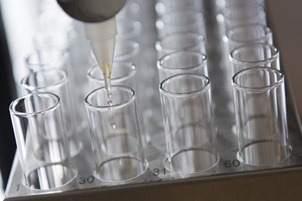An automated machine works on purification of potential hepatitis C virus drug candidate at the Gilead Sciences Inc. lab in Foster City, California. Photographer: David Paul Morris/Bloomberg
Bloomberg News
By Ryan Flinn on April 12, 2012
Gilead Sciences Inc. (GILD) (GILD), after paying $10.8 billion for the developer of an experimental hepatitis C drug, will soon give investors a better sense of whether its largest-deal ever is going to pay off.
Beginning next week, Gilead will release data from dozens of patients who have tried the medicine, providing the most complete evidence yet about its prospects for treating 170 million people who are infected with the virus globally. Trial results reported in 10 people in February spurred wild swings in the company’s stock price.
Gilead, the world’s largest maker of HIV drugs, has fallen 10 percent in the past four years, and is facing the loss of half of its revenue from patent expirations on AIDS medicines beginning in 2018. Despite that, 26 analysts (GILD) advise buying the shares, and seven suggest holding them.
“They will be there as one of the key players to treat a very large unmet medical need in hepatitis C, and one of the first players,” said Joshua Schimmer, a Leerink Swann & Co. analyst. “You can make a very strong case that Gilead shares are worth owning through the volatility.”
The purchase of Pharmasset Inc., announced Nov. 21, was designed to add a heavyweight product to diversify Gilead in an area -- infectious disease -- where the Foster City, California-based biotechnology company has expertise and an established sale force.
The company became a leader in AIDS treatments by finding the right combinations of drugs to help change the disease from a quick killer into one that’s manageable. Researchers say hepatitis C also may be attacked with drug cocktails. It’s a matter of finding “the right recipe,” said Mani Subramanian, a Gilead vice president of clinical research.
Liver Meeting
Investors are looking to results to be reported beginning at next week’s European Association for the Study of Liver meeting in Barcelona to define what role Gilead’s hepatitis C drug, known as 7977, will play in a developing market for new medicines that is expected to reach $20 billion.
In data reported on Feb. 2, four weeks of Gilead’s medicine seemed to eradicate the virus in 10 patients who hadn’t responded to prior rounds of therapy, boosting the company’sstock market value (GILD). On Feb. 17, when some patients relapsed, Gilead shares fell the most in 11 years.
“You have to be kind of astounded by it,” Leerink Swann’s Schimmer said in a telephone interview.
One key study weighs the performance of Gilead’s 7977 in tandem with an experimental product from Bristol-Myers Squibb Co. (BMY) (BMY) when used by all types of patients. Others will report on 7977’s effectiveness in those who have never been treated.
Bristol-Myers Compound
Bristol-Myers’s compound, BMS-790052, hinders a protein called NS5A that creates a scaffolding around the virus, securing it so it can replicate, Gilead’s Subramanian said. His company’s drug integrates itself into the virus’s replicating process, preventing it from churning out copies.
The new hepatitis C drugs also promise to work more quickly and be safer than the current standard of care that combines an antiviral called ribavirin with interferon, an injectable immune-boosting protein, studies have shown.
“We’re very excited about this Bristol-Myers study,”Subramanian said in an interview at the company’s headquarters.“We’ll know whether you even need ribavirin if you have a NS5A in the mix.”
Proving the worth of Bristol-Myers’s product in combination with 7977 could also help Gilead down the line when GS-5885, its own NS5A inhibitor, is put before the U.S. Food and Drug Administration for approval. The product is now in the second of three phases of trials generally required for clearance.
Ribavirin Combination
Gilead is expected to report at the Barcelona conference how 7977 works in combination with ribavirin after 12 weeks of therapy in those who haven’t had other treatments before, so-called naïve patients. This will help establish which patients can be cured, or not, without interferon.
If Gilead’s hepatitis C drug is approved, at the end of 2013 at the earliest, it may add $3 billion to $4 billion in revenue by 2018, said Michael Yee, an analyst with RBC Capital Markets in San Francisco. That would help replace sales from Atripla, the most widely used HIV medicine, and Truvada, a component of Atripla, he said. The medicines generated $6.1 billion in 2011 sales, or 73 percent of Gilead’s revenue.
“The company did have very steady revenue and earnings growth, but they’re looking to accelerate that,” Yee said.“The growth potential of the company has significantly changed, with higher risk and higher reward.”
No Death Knell
The finding last month that some patients have relapsed shouldn’t be looked at as a death knell for the developing product, Gilead’s Subramanian said.
The data “means one of two things,” he said in an interview. “Do you need longer duration, or more drugs?”
Geoff Porges, an analyst with Sanford C. Bernstein & Co. in New York with a market perform rating on Gilead, isn’t so sure.
The failure of 7977 to cure people who had previously been treated “shocked the world,” and means Gilead won’t dominate the field as some had expected, he wrote in a note to clients.“It changes the treatment landscape,” he wrote, and“highlights the vulnerability of Gilead’s stock to any stumbles.”
Subramanian remains philosophical about the hepatitis c therapies: “It’s like cooking,” he said. “At some point we’ll figure out the right recipe.”
To contact the reporter on this story: Ryan Flinn in San Francisco at rflinn@bloomberg.net
To contact the editor responsible for this story: Reg Gale at rgale5@bloomberg.net

No comments:
Post a Comment